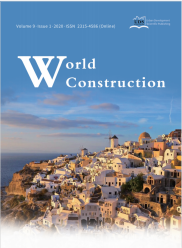Vol 1, No 1 (2012)
Table of Contents
Articles
|
265 Views, 86 PDF Downloads
Fang Du, Yong Li, Feng Wu DOI:10.18686/wc.v1i1.25 AbstractThere are often no windows and lack of natural light in the most of underground space, so lighting design is the most basic for most underground architectural design. Natural lighting is not only for comfortable indoor energy-saving and healthy light environment, but also for the good indoor environment. We need to use natural light and artificial lighting conduction system to offset the lack of natural light and improve the effect of underground space of natural light.
|
1−4
|
|
300 Views, 53 PDF Downloads
Shan Bai DOI:10.18686/wc.v1i1.31 AbstractWith the rapid development of the country's overall per capita consumption level has been greatly improved, so as the development of urbanization, the demand for urban housing construction has greatly increased, and people's living standards but also pay more attention to improve energy saving urban housing, in order to ensure the health of people living environment, green, green. Furthermore, urban residential building energy saving marks the development of urban modernization, strictly follow the principle of sustainable development in our country. With the development of society, resources and energy consumption of large quantities of now, we do not just want to ensure the quality of people's living standards and even possible to reduce energy and resource consumption, so that energy-saving design of urban residential buildings became heavy in the weight. Therefore, this article on some of the problems of urban residential building energy efficiency design of the existence of and the factors affecting these issues briefly analyze and find appropriate solutions to ensure that the urban residential buildings not only meet the needs of people's lives but also to achieve energy saving and environmental protection role. |
20−22
|
|
255 Views, 52 PDF Downloads
Ling Wang DOI:10.18686/wc.v1i1.27 AbstractBased on the national situation and combined with status of building energy consumption, building energy saving development planning is the most effective measure to deal with the building energy consumption problem in China. Given the building energy saving development planning problem, proposals are given in terms of the planning patterns, planning flow and the organization, which would be of practical value to the implementation of building efficiency planning in China at current stage. |
9−14
|
|
219 Views, 65 PDF Downloads
Xiang Liu DOI:10.18686/wc.v1i1.26 AbstractFrom the most  basic visual physiological characteristics among of the decisive factors of spatial scale , the control of stadia and visual angle on the garden space distribution and the common  quantification control laws   on spatial scale were analyzed and summarized.
|
5−8
|
|
262 Views, 47 PDF Downloads
Bin Tang, Dongqing Han DOI:10.18686/wc.v1i1.28 AbstractAn ideal urban planting mode of contemporary cities is discussed, and the |
15−19
|





